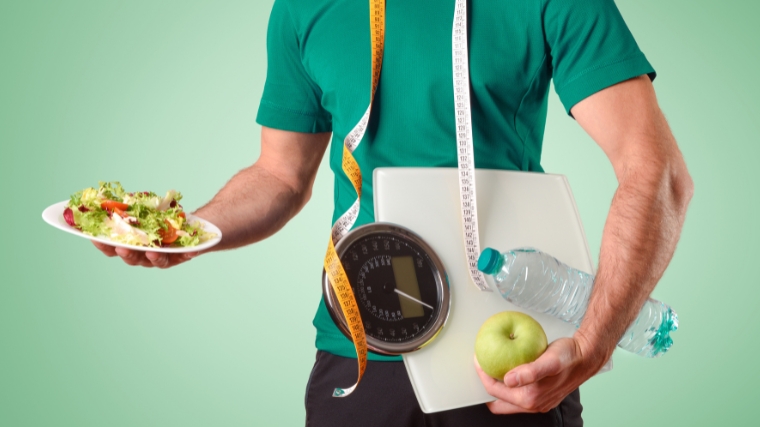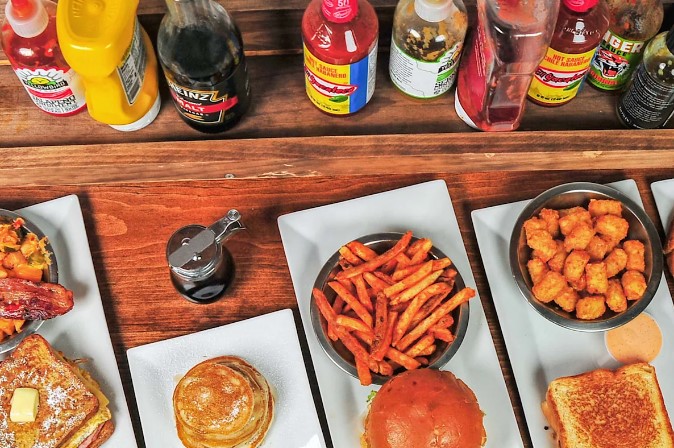Fitness and Nutrition Awards – Best Training Products 2023

As a cyclist, bettering performance certainly involves time on the bike. But that’s not the only way to see gains. Cross-training, recovery, and fuel all contribute to stronger rides. Let these editor-tested top fitness and food choices feed your muscles and your miles, whether you’re lifting weights, clocking intervals, building endurance, or taking crucial downtime.
Your Guide to the Best Training and Nutrition Products for Cyclists:
HOME GYM ⬩ APPS ⬩ RECOVERY ⬩ WEARABLES ⬩ NUTRITION
The main goal of a home-gym setup: inspire you to move more. This list will help you lift, stretch, and kick up your cardio right in your own space. Each product makes training indoors a little easier and way more fun. So you keep moving even if you can’t ride outside.
Best Training Shoe
When doing squats, deadlifts, glute bridges, and even upper-body exercises, it’s important to feel the ground beneath you—pushing through your feet as you come to the top of the movement or grounding down for balance. These training shoes let you do just that. They feel pretty minimal underfoot. But that’s not a bad thing, as it lets you feel that ground contact. They also have lots of flexibility in the forefoot if you add plyometrics, like box jumps or skaters, into your routine. And the BOA closure allows for a tight but not restrictive fit.
Best Indoor Cycling Shoe
The Shimano IC501’s almost sock-like construction makes it a standout in terms of comfort. It’s the breathable mesh upper that gives it that stretchy, fitted-to-your-foot feel. The material also means you get superior airflow, keeping your feet cool even as you heat up throughout your workout. While the bottom of the IC501 is a little more flexible than other shoes, the reinforced plate throughout the shoe’s length still allows for efficiency and power as you press and pull through each part of your pedal stroke.
Best Indoor Budget Bike
If your budget doesn’t allow for a dedicated indoor bike over $1,000, this is a great substitute. You can connect to the Peloton app, as well as Zwift, via Bluetooth so you can see your workouts on screen. It also tracks and displays your time, speed, mileage, heart rate (if you connect a monitor), and resistance. While you won’t get wattage or precise rpm, you can see that data on third-party apps. The ride is smooth, the construction allows for adjustability to fit your body, you can crank up the resistance, and you have the option to ride with shoes in cages or clip in with SPD-style cleats.
Best Inexpensive Zwift Setup
To get in on the fun of Zwift’s immersive experience, you don’t need to spend a lot of money on your setup. All you need are these two less-expensive tools that make tracking your workouts super simple and help you improve your speed and power.
To get everything working properly, first attach the Garmin sensor to your bike’s rear hub. Then just connect that sensor to Zwift, enter your tire size, add your trainer, and you’re good to go. This will input your speed and watts into Zwift so you can race the competition.
READ MORE ABOUT THE SETUP
Best Indoor Smart Trainer
One of the least expensive smart trainers you can buy that directly connects to Zwift, this direct-drive-style trainer not only measures power and transmits that information to the game, but also allows Zwift to adjust the resistance to simulate in-game terrain. This makes the experience of riding indoors more immersive. The Hub has +/– 2.5 percent power accuracy, 1,800 watts maximum, and up to 16 percent incline simulation, plus ANT+ and Bluetooth connectivity.
Unlike most other direct-drive trainers, the Hub comes preinstalled with a cassette, and riders can specify cassette compatibility for 8-speed through 12-speed systems. This decreases the overall cost and means you won’t need to source additional parts or get them installed. In other words, it makes the setup pretty smooth.
Zwift also sends color-coded thru-axle templates and cards that you can use to measure your bike’s rear dropouts and easily figure out which adapters are needed to fit your bike to the trainer.
As for the ride itself, it’s quite good. In terms of feel and inertia, it’s as solid as the pricier Wahoo Kickr Core. It’s also essentially silent. The only noise you’ll likely hear will be either your bike’s drivetrain or your fan.
Our main critique of the Hub is that it doesn’t fold up or have adjustable legs. But if you’re not tight on space and have pretty even floors, this is the most cost-effective way to get the full virtual training experience that Zwift and other apps offer.
READ THE FULL REVIEW
Best Fitness Mat
Lululemon makes the best yoga mats, offering a soft feel, yet grippy texture, so you stay comfortable while sticking poses. The company recently launched the latest addition to its lineup, simply named The Workout Mat, which improves upon an already stellar product.
Designed for more intense and dynamic movements—like explosive plyometric exercises and side-to-side movement patterns—the mat feels super plush underfoot but still offers traction so you’re not sliding around with each step. At six millimeters thick, it’s also great for stretches or other exercises requiring more support under your knees or elbows (think forearm planks or kneeling hip-flexor stretches). While the price might seem hefty, it’s worth it for a comfortable and safe space for your at-home workouts.
Best Dumbbells
Adjustable dumbbells allow you to have a range of weights within hand’s reach without taking up tons of space. While many adjustable dumbbells are difficult to actually alter or have clanky weights, this set from NordicTrack makes it easy and smooth to switch from 10-pound dumbbells in a reverse fly to 35-pound for your deadlift.
Ranging from 5 pounds to 50 pounds each, a simple turn of its center knob gives you access to lighter or heavier weights. And if you don’t feel like turning the dial, you can connect these weights to devices like the Amazon Echo to let Alexa know you want them set at 10 pounds or ready for your squat weight (you just have to set your go-to weight for certain exercises in the app). With this set, it’s simple to keep progressing your load and making strength gains that pay off in injury prevention and enhanced power.
Best At-Home Fitness Class Experience
Lululemon Studio brings a group fitness atmosphere right to your home. Formerly known as the Mirror (Lululemon purchased the system in the summer of 2020 and rebranded it in October 2022), the device itself looks discreet when you’re not using it. It’s just a full-length mirror that you can stand anywhere or mount on the wall. When it’s time to kick off your workout session, the instructor appears on-screen, leading you through classes including strength, barre, boxing, and many more. Seeing the trainer makes for a studio-like experience, plus you can set the music genre for the class, leaving you with jams that motivate you the most.
In the fall, Lululemon Studio teamed up with fitness studios like Pure Barre, Rumble, and Y7 to offer their classes on the platform. And if you’ve missed going to boutique studios, or always wanted to try these popular classes, Lululemon Studio is a great way to do it. You get the enthusiasm and expertise of instructors in different training modalities, making workouts more exciting (and challenging if you’re new to the particular type of training). Plus, it gives you a pretty stellar way to add variety to your routine. This keeps a fitness program from getting boring because you have so many options for trying something new—and then you can keep going back to the classes you love most.
What’s more, for your motivation: You can take shorter classes from these studio partners (which you wouldn’t get in person) so you can easily sweat it out between meetings or to-dos. To top it off, Lululemon Studio comes with a discount to shop Lululemon, plus a discount to take classes from its studio partners IRL.
Best Connected Strength Device
If you already love Peloton’s cycling workouts but want to kick up your strength training, the Guide is for you. It’s also helpful for anyone looking to start a weight-training program that takes some of the guesswork out of planning efficient, effective workouts. The Guide has a built-in camera for “self-mode,” allowing you to see your form on-screen and compare it to the trainer’s form as you move through a workout. It also has a “Movement Tracker” that not only gives you credit for your strength moves but also keeps track of the body parts you work the most. That way, it can suggest routines for the muscles you tend to neglect. (For example, if you’re consistently cycling and doing leg workouts, it’ll suggest some core and upper-body sessions.)
The Peloton Guide also added a “Rep Tracking” feature to the Guide so you can keep track of your strength-training volume over time—a key to avoiding a workout plateau. Your weights for each workout are also stored for future tracking, helping you keep a closer eye on your progress.
The best part about using Guide is that it makes it easy to follow a well-rounded strength program. You can choose to follow specific weeks-long programs, like coach Tunde Oyeneyin’s four-week arm-focused workouts or the four-week floor boot camp program from Selena Samuela and Jess Sims. Or follow the “Roll Call” schedule. This offers up your strength workouts for the week, mixing total-body, upper-body, lower-body, and core sequences to provide a variety of moves that can all be done in 30 minutes or less. It makes your strength workouts as easy as firing up the Guide, pressing play on Roll Call, and following the daily workout.
To top it off, Peloton seamlessly connects to Apple Watch (and other heart-rate monitors), so you can see your heart rate throughout class. Plus, you get a “Strive Score,” calculated based on the time you spend in each heart-rate zone.
READ MORE STRENGTH TRAINING FOR BEGINNERS
CHECK OUT MORE OF THE BEST APPS FOR CYCLISTS
Giving your body some TLC is just as important as training. Rest is how you build strength, improve cardio, and see progress. These devices assist in that rejuvenation process, making recovery sessions just as exciting as your workouts.
Best Massage Gun
This compact percussion therapy device keeps up with the Theragun and Hyperices of the world but in a smaller (and arguably better-looking) package. It comes with four speeds and four attachments so you can find the right intensity for every area of the body. Turn it up to work out those quads; turn it down to go a little easier on your shoulders. The device also rings in a bit quieter than some of its rivals. Plus, it comes with a carrying case that makes it easy to stash in your bag and four color options.
Best Compression Therapy
Normatec is the go-to for compression therapy—a tool for giving the legs an air massage before and after long, hard miles. But because the typical full-length sleeves take up the entire leg, and include a pretty hefty hose attachment to feed the sleeves the air, they’re difficult to take anywhere. These calf sleeves, however, offer a much more travel-friendly option. Equipped with rechargeable battery packs that power the airflow, the sleeves offer targeted compression straight to the calves. Seven levels of that compression mean you can get a more intense 360-degree massage on the lower legs whenever you need it.
Best Foam Roller
If you don’t want to spend a lot on your recovery tools, you can still get great myofascial release with this dense foam roller. Costing about $20, the roller’s hard surface will help you find relief in the quads, glutes, hamstrings, and calves. And you can easily use it for the upper body, too. Lie on it vertically, with everything from your glutes to your head supported, and you can open up the chest. Feel a massage through the shoulders and back when you move your arms in a snow-angel-like motion. This move—and any way you roll—is the perfect way to stretch it out after a long ride.
TRY THESE FOAM ROLLER EXERCISES
Readiness scores and recovery feedback can be helpful for cyclists. As active individuals, we push our bodies’ limits in workouts and need adequate rest to see performance improvements.
Two measurements come into play when tracking recovery: resting heart rate (RHR) and heart-rate variability (HRV, the time between beats). A higher HRV typically means lower stimulation of your fight-or-flight response (your stress response) and better activation of the rest or digest state, or your more relaxed mode, explains Tamanna Singh, M.D., sports cardiologist at Cleveland Clinic. Things like sleep, alcohol, fueling, and training can affect both RHR and HRV. While it’s a positive to have a higher HRV, that’s relative to you as an individual. The goal is really stability over time, says Erica Marshall, Ph.D., C.S.C.S., assistant professor of exercise science at Florida Southern College.
Both Singh and Marshall agree that devices help you spot trends, providing insight into these numbers so you know where to focus to get healthier and fitter. For example, they might clue you into the need for better sleep habits, more rest days, or less alcohol.
Above all, listen to your body over depending on a device. But if your tracker tells you it’s time for a recovery day, it’s a good reminder to check in with yourself—because maybe you could use more time to relax.
Best for In-Depth Stats
In addition to top-level GPS accuracy for more precise stats like distance and pace, the Forerunner 255 also offers tons of training data on your wrist. You can see essential stats like heart-rate zones, aerobic versus anaerobic activity within a workout, and VO2-max estimates. It will also provide riding metrics from connected devices like power meters or e-bikes.
In terms of helping you with your recovery goals, you get a sleep score (which takes into account RHR and HRV), a “Recovery Time” metric (which estimates how much rest you need after every workout), and “Training Status” (peak, productive, unproductive, or maintaining), which may suggest when you need to swap out high-intensity activities for more low-key workouts.
The 255 Music easily pairs with many of your favorite indoor trainers, connects with popular streaming music services like Spotify, and has a nearly two-week battery life in smartwatch mode or 30 hours if using GPS.
Best Budget-Friendly Tracker
Fitbit’s platform is very user-friendly, making it easy to see your stats, track your workouts, and get insight into your movement and recovery. The Inspire 3, in particular, discreetly tracks your everyday activity, thanks to its slim, sleek design. Its standout features include automatic activity tracking, zone minutes (or how much time you spend in your fat-burn, cardio, and peak heart-rate zones), and sleep tracking.
Based on activity levels, sleep quality, and HRV, you also get a readiness score to help determine how much to push in your workouts, along with a stress management score, complete with tips on taking control of your stress. The best part: You get all of this for a much lower price than other smartwatches.
If you want more insight into your sleep, a premium Fitbit membership ($10/month) tells you if you hit the ideal range for important rest factors, like sleep-schedule variability, duration (overall and in deep and REM sleep), and restorative sleep (how much time you spent below your typical RHR).
Best for Easy Integration
If you’re an iPhone user, nothing quite compares to owning an Apple Watch. The seamless connection between your watch and phone means you can always stay connected to calls, texts, meetings, and reminders. When it comes to training, Apple Watch also received some pretty useful updates over the past year to both the watchOS system in general and Series 8 specifically. Those updates include heart-rate training zones, better GPS, access to more stats you care about right on the screen, and fall detection (which activates emergency services if you’re unresponsive). Automatic tracking for Outdoor Cycling and auto pause and start also makes it easy to record ride metrics, even when you forget to check your watch consistently.
With the Apple Health app, you also get more in-depth sleep tracking, helping you stay in tune with your rest.
While you might have seen the launch of Apple Watch Ultra—a great choice for those heading into the woods and riding trails—road and pavement riders can stick with the Series 8, as it’s easier on the wallet.
Best Recovery Tracker
Oura Ring offers a super comfy alternative to smartwatches and stands out for putting rest first. You get a few measurements on the corresponding app: readiness, sleep, and activity levels. Oura Ring monitors RHR, HRV balance, body temperature, recovery index, sleep trends, sleep balance, and the previous day’s activity. Then, you get a score based on those numbers. Thanks to that temperature integration, the Ring can (pretty much) be an indicator for when you’re sick, reminding you to take extra rest.
Your sleep stats include REM, deep-sleep hours, and the percentages they make up for your nightly rest. It provides latency (the time it takes you to fall asleep), timing (it suggests your best bedtime), efficiency (time spent asleep versus awake in bed), and restfulness (which can indicate the quality of your zzzs).
While the Oura Ring also tells you calories burned and steps taken, the more eye-opening stat is inactivity for the day and whether you should move more every hour. Overall, it gives a solid picture of your activity compared to your rest, and to which one you owe more attention.
When it comes to choosing packaged foods for a meal or snack before, during, or after a ride, you want those that pack in nutrients and have a short ingredient list, says Kristen Arnold, R.D., a sports dietitian and level 2 USA Cycling coach. Aim for about 100 to 300 calories in your pre- and postride snacks, reaching for more carbs (about 20 to 40 grams per serving) before you start pedaling and more protein (about 15 to 30 grams per serving) after you’re done. It’s also helpful to avoid products with sugar alcohols and those high in fiber before your workouts, as those can lead to stomach issues, Arnold says. To help you hit your nutrition goals, stock up on these fueling foods.
READ MORE ABOUT FUELING YOUR RIDES
Deputy Editor, Health & Fitness
Mallory Creveling, an ACE-certified personal trainer and RRCA-certified run coach, joined the Runner’s World and Bicycling team in August 2021. She has more than a decade of experience covering fitness, health, and nutrition. As a freelance writer, her work appeared in Women’s Health, Self, Men’s Journal, Reader’s Digest, and more. She has also held staff editorial positions at Family Circle and Shape magazines, as well as DailyBurn.com. A former New Yorker/Brooklynite, she’s now based in Easton, PA.















































